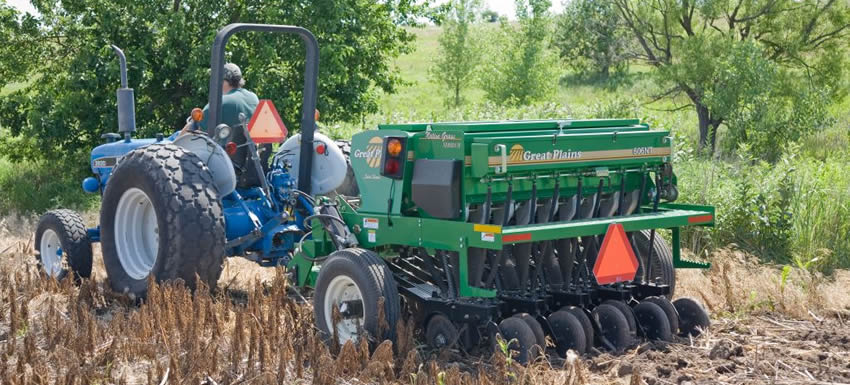No-Till Drill

The RCD owns a compact rangeland No-Till Drill (NTD) which is available for rent at low cost to landowners. The drill is most appropriate for rangeland and pasture settings, as well as cover crop seeding for veggie farms (if you have wide enough gates). It is too wide for vineyard rows and it is too tall for orchard trees. Please note that the use of this drill is strictly limited to Sonoma and Marin Counties. If you are inquiring from a surrounding county, we encourage you to contact your local RCD and express your interest in using a No-Till Drill. If they receive feedback about the need for a drill in your community, then perhaps grant funds can be obtained to purchase the equipment.
The No-Till Drill is available for $150/day for residents within the GRRCD and $200/day for residents outside of the district. Each year, the drill is typically used by 15 to 20 landowners. Each year we receive inquiries from 30 to 35 landowners, and we are unfortunately unable to serve every person who inquires.
How it Works: Our machine is a Great Plains 606NT 6-foot No-Till Drill. The NTD is a towed seeding implement with end wheels and it has a planting width of 7.5 feet and an overall width of 11 feet. The opener discs make a seed bed, and seed tubes mounted between the discs place seed in the furrow. Press wheels following the opener discs close the furrow and gauge opener seeding depth.
We also require that you follow the manufacturer’s instructions not to exceed 20 miles per hour when transporting the drill from site to site. It weighs 2,700 pounds. Towing at high speeds or with a vehicle that is not heavy enough could lead to loss of vehicle control. Loss of vehicle control could lead to serious road accidents, injury and death. To reduce the hazard, do not exceed 20 mph.
Benefits of conservation tillage: Depending on its condition or state, soils are a living dynamic organism that functions in a holistic way, rather than as an inanimate mixture of sand, silt, and clay (Doran, 1999). Soils are neither good nor bad; rather soils are either healthy or unhealthy, the difference being that healthy soils have the capacity:
- To function as a vital living system (within ecosystem and land use boundaries);
- To sustain biological productivity; To promote the quality of air and water environments; and
- To maintain plant, animal, and human health.
No-till seeding provides winter vegetative cover without tilling the soil, improving soil permeability and reducing both runoff and erosion. Because there is no tillage, use near water bodies does not endanger water quality but acts to protect and enhance it, as improving vegetative cover during the winter further reduces runoff and erosion. A no-till approach leaves plant residue (from harvest, cover cropping, etc.) on the surface, rather than tilling it in, which further protects the soil from erosion and imparts additional benefits.